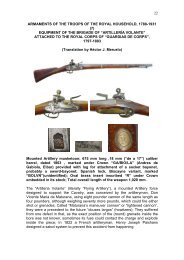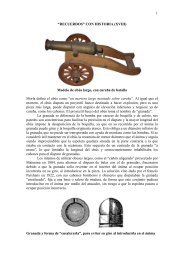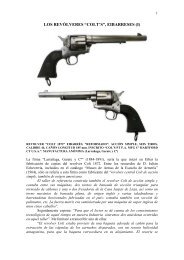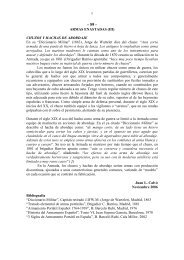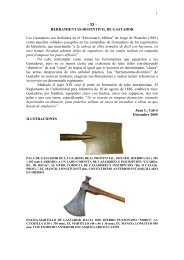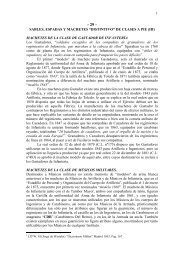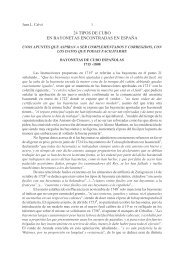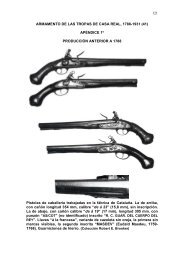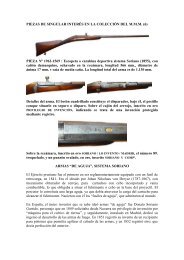1 PORTABLE WEAPONS PRODUCTION IN SPAIN During the XVIII ...
1 PORTABLE WEAPONS PRODUCTION IN SPAIN During the XVIII ...
1 PORTABLE WEAPONS PRODUCTION IN SPAIN During the XVIII ...
You also want an ePaper? Increase the reach of your titles
YUMPU automatically turns print PDFs into web optimized ePapers that Google loves.
1<br />
<strong>PORTABLE</strong> <strong>WEAPONS</strong> <strong>PRODUCTION</strong> <strong>IN</strong> SPA<strong>IN</strong><br />
<strong>During</strong> <strong>the</strong> <strong>XVIII</strong> century, firearms in Spain, with <strong>the</strong> only exception of <strong>the</strong> Madrid<br />
archebusiers who had been liberated in 1710 of all ties to <strong>the</strong> Guilds by Philip V 1 were<br />
manufactured by <strong>the</strong> four Guilds of craftsmen that functioned in each “factory,” which<br />
included <strong>the</strong> barrel makers, <strong>the</strong> lock makers, <strong>the</strong> gun stockers and <strong>the</strong> finishers; Only<br />
those craftsmen with <strong>the</strong> rank of “master” could work on that part of <strong>the</strong> weapon of <strong>the</strong>ir<br />
competence.<br />
Those geographical areas where <strong>the</strong> manufacturers were concentrated were<br />
called “factories”, and, “Royal Factories” if <strong>the</strong>y manufactured <strong>the</strong> King’s arms; Those<br />
arms paid for by <strong>the</strong> Royal Purse were inspected by <strong>the</strong> “King’s examiners” who had to<br />
certify by <strong>the</strong>ir personal markings that each weapon had passed <strong>the</strong> proof and <strong>the</strong><br />
regulation “visual” inspection; In contrast, for those weapons made for “private” parties<br />
<strong>the</strong> maker’s markings on <strong>the</strong> barrel and lock were deemed to be sufficient guarantee.<br />
In <strong>the</strong> early XIX century <strong>the</strong>re were “Royal” firearms factories in Placencia,<br />
Cataluña, and Oviedo; The Placencia factory employed artisans from <strong>the</strong> towns close to<br />
<strong>the</strong> Deva river and had its reception centers in <strong>the</strong> towns of Placencia (Soraluce) and<br />
Eibar; That of Oviedo (in Asturias) had its Guilds in Oviedo itself and in neighboring<br />
Trubia, and that of Cataluña, by <strong>the</strong>n practically ruined, had its Guilds in Ripoll and<br />
Barcelona.<br />
The first person to be recognized in Spain as a “manufacturer” of edged weapons and<br />
firearms was Gabriel Benito de Ibarzabal of Eibar; His edged weapons were made in his<br />
own workshop but <strong>the</strong> firearms, judging by <strong>the</strong> markings on locks and barrels, were<br />
privately subcontracted by him to <strong>the</strong> Placencia guilds.<br />
Ibarzabal started as a “manufacturer” of firearms immediately after <strong>the</strong> Cortes<br />
made it possible in May of 1820, and his “factory” survived <strong>the</strong> derogation of <strong>the</strong> Cortes<br />
decrees in 1823.<br />
The coming of <strong>the</strong> industrial freedoms in 1836 caused no changes in <strong>the</strong> production of<br />
army issue weapons at <strong>the</strong> Oviedo and Placencia factories which continued to function<br />
on <strong>the</strong> Guild system, which was not dissolved until 1858 when <strong>the</strong> artisans were hired<br />
directly as workmen by <strong>the</strong> Artillery Corps, while <strong>the</strong> Royal Placencia Factories were<br />
closed in January of 1865.<br />
The different destiny of both factories was due to <strong>the</strong> fact that <strong>the</strong> Oviedo Factory<br />
was property of <strong>the</strong> State, having been created in 1794 and paid for by <strong>the</strong> Royal Purse,<br />
and that it was modernized in 1844 by Officers of <strong>the</strong> Artillery Corps, while in Placencia<br />
<strong>the</strong> only State property was <strong>the</strong> “Errege-etxea”, <strong>the</strong> King’s House, where <strong>the</strong> Guild<br />
masters brought <strong>the</strong>ir production to be inspected by <strong>the</strong> “King’s examiners”; Its<br />
workshops, disseminated along <strong>the</strong> Deva river were <strong>the</strong> property of <strong>the</strong> Guild members<br />
1 According to Isidro Soler in is “Compendio Histórico de los Arcabuceros de Madrid” (Historical<br />
Compendium of <strong>the</strong> Madrid Archebusiers)<br />
8
and it was <strong>the</strong> Guilds who imposed <strong>the</strong>ir prices and conditions on <strong>the</strong> Army and Navy<br />
contracts.<br />
<strong>During</strong> <strong>the</strong> 1850s a number of firms came into being which were interested in<br />
producing <strong>the</strong> modern issue armaments required by <strong>the</strong> Army including, in Placencia,<br />
<strong>the</strong> so called “Euscalduna” which was a modern factory owned by <strong>the</strong> “Zuazubizcar, Isla<br />
y Compª” firm.<br />
As far as commercial arms production it was around 1836 that <strong>the</strong> classic individual<br />
masters markings, applied to (by <strong>the</strong>n percussion) pistols and shotguns began to be<br />
substituted by a single barrel inscription which pronounced <strong>the</strong>m <strong>the</strong> product of a certain<br />
maker or factory, usually from Eibar.<br />
Eibar made “commercial” pistol; 193 mm long, 18 mm bore, forged barrel bearing<br />
a silver inscription on its handle: “Fabricado / Por Jose Ramon Bustinduy / Año<br />
1840”, with octagonal chamber, mounted in <strong>the</strong> English style; Lock with chain,<br />
inscribed “En Eybar”; Full stock and engraved iron furnishings.<br />
In his “Viaje al País de los Recuerdos” 2 , Toribio Echevarria tells us that “In those times it<br />
was <strong>the</strong> Manchester school that was in vogue and it was in that spirit that <strong>the</strong> so called<br />
“Montadores” appeared; These “Montadores” (assemblers, literally), who were also<br />
businessmen, obtained <strong>the</strong> orders, from within Spain and abroad, and had <strong>the</strong>m filled by<br />
<strong>the</strong> master craftsmen who worked <strong>the</strong>ir specialties independently in <strong>the</strong>ir own shops,<br />
and <strong>the</strong>se successive assembly operations, hence <strong>the</strong> name “Montadores”, produced<br />
<strong>the</strong> complete weapon, ready to be marketed; Those who succeeded in this type of<br />
enterprise gradually began to unite <strong>the</strong> different specialists under one roof, under one<br />
boss, and became a factory”.<br />
The first “Montador” was Gabriel Benito de Ibarzabal, followed by all those who<br />
put <strong>the</strong>ir name in weapons <strong>the</strong>y marketed, including his son Ignacio Ibarzabal who in<br />
1852 inherited his fa<strong>the</strong>r’s factory, and also <strong>the</strong> Orbea bro<strong>the</strong>rs who founded <strong>the</strong>ir own<br />
in 1860; From this date until 1873 <strong>the</strong>se were <strong>the</strong> only “factories” in Eibar and, after <strong>the</strong><br />
end of <strong>the</strong> Civil War, “Orbea Hermanos” was <strong>the</strong> only remaining one until 1897, when<br />
<strong>the</strong> workshop of “Garate, Anitua y Cia” started to be classified as a factory (by <strong>the</strong> tax<br />
collector).<br />
2 Travel to <strong>the</strong> Country of Memories<br />
9
It was in <strong>the</strong> manufacture of “fine hunting arms” that mastery of <strong>the</strong> craft was required,<br />
because, as noted by Echeverria: “in <strong>the</strong> field of handguns less personal professional<br />
skills were necessary as machines were introduced very early in <strong>the</strong>ir manufacture and<br />
<strong>the</strong>ir use became generalized faster”, even though <strong>the</strong> machinery available to <strong>the</strong>se<br />
workshops at <strong>the</strong> time probably did not allow for a very high quality product.<br />
Toribio Echevarria used to tell of a house in Eibar where Ignacio Galarraga, who<br />
was a Socialist, had his shop in <strong>the</strong> first floor, while at <strong>the</strong> same time two bro<strong>the</strong>rs who<br />
were furious Carlists (monarchist followers of <strong>the</strong> Carlist pretender) worked in <strong>the</strong> attic<br />
making “cachorrillos”, cheap pistols that were sent to Constantinople and distributed<br />
throughout <strong>the</strong> Middle East; Not only was this cohabitation of two so diametrically<br />
opposed political philosophies a common occurrence in those times, but also frequent<br />
was <strong>the</strong> presence of several different workshops functioning in <strong>the</strong> same house, where<br />
many of <strong>the</strong>m were also engaged in producing cheap pistols which <strong>the</strong> “Montadores”<br />
<strong>the</strong>n marketed inside Spain and also exported to Turkey, <strong>the</strong> Balkan countries, Mexico<br />
and South America.<br />
10



